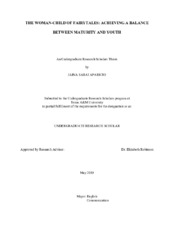| dc.description.abstract | Literature Review: A number of scholars have noticed similarities in what societies within fairy tales expect of women and children and how they treat them, but scholars tend to keep the spheres of childhood and adulthood separate. Maria Tatar for instance, notices a link between women and children in the disciplinary consequences that befall both groups, who are perceived as committing the same types of sins. For instance, mere curiosity is considered grounds for punishment, which position women and children in ways that emphasize their deferential functions in society. Similarly, Sandra Gilbert and Susan Gubar link the similarity between woman and child with what they read as an internal struggle happening within the fairy tale woman. The Wicked Stepmother of the Grimm’s Snow White is read as a woman who wants to take control of her own life and write her own story, whereas Snow White represents the kind of deferential innocence that could kill the Queen if it were ascribed to her. In opposing the princess, the Wicked Stepmother is fighting to keep her life of action and agency by attempting to kill her inner passivity, her inner Snow White. She is thus positioned between two conflicting states of being, the first an angel and the other a witch. Cristina Bacchilega notes how the process of naturalizing innocence and the desire for children as part of organic womanhood allows for a dependency on the patriarchy and heterosexuality in order to achieve her ‘natural state.’ In centering a woman’s spotlight primarily on her as a child and then on her having one of her own, her experiences are narrowed until society can only see her as either a child or mother. Thesis Statement: This paper argues for the existence of a ‘woman-child’ by examining how successful fairytale women are simultaneously symbolically associated with both adult and childlike states, as well as how those who become too adult-like or childlike are punished by their narratives. Theoretical Framework: This paper draws upon feminist and psychoanalytical theory to explore gender issues and how these interact with childhood inside of both folktales and the larger context of children’s literature and culture. Project Description: Through an analysis of gender relations, it is possible to recognize an identity struggle going on within fairy tale women as they are pushed by their societies to become what this project has coined a ‘woman-child,’ a female who embodies culturally desirable — and sometimes contradictory — attributes of both adulthood and childhood simultaneously. By evaluating Perrault’s “Bluebeard,” the Grimms’ “Snow White,” “The Frog King,” “The Virgin Mary’s Child,” and “Brother and Sister,” this paper points out how a number of symbolic motifs, plot devices, and objects that have been interpreted by critics to represent adult traits such as sexual maturity, passion, and puberty are juxtaposed with other symbolic elements that represent childlike traits such as submissiveness, purity, and naivety. | en |


